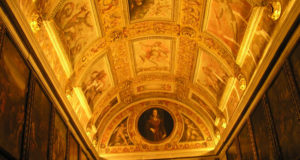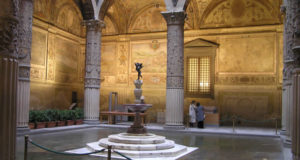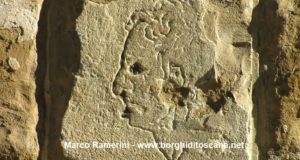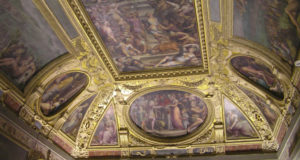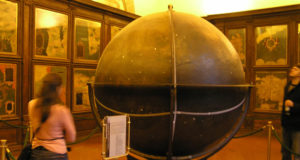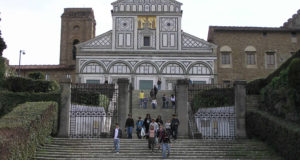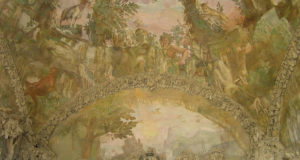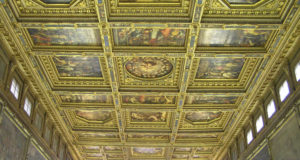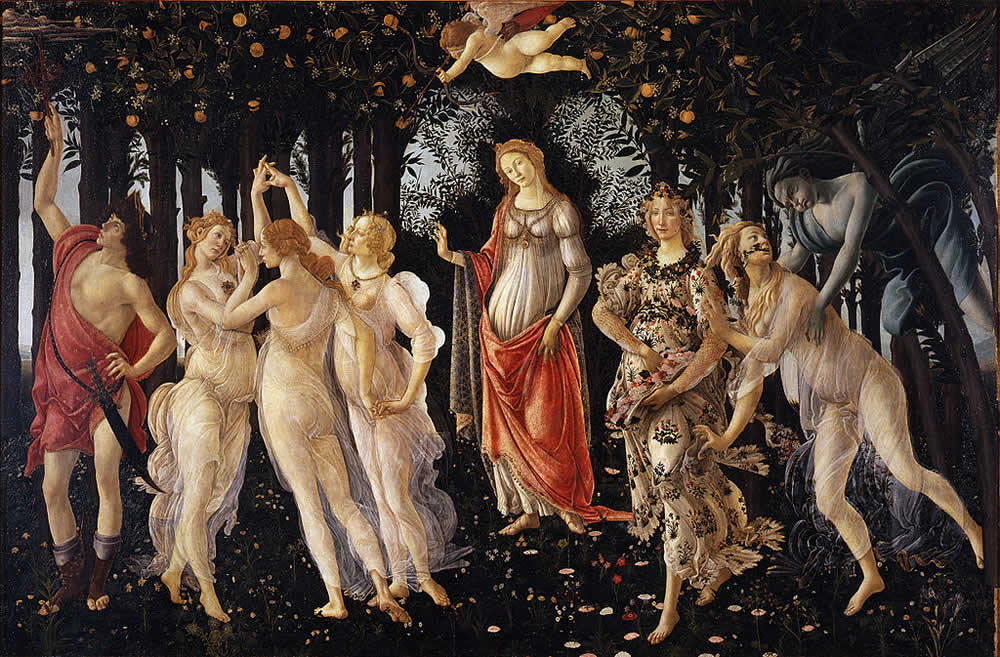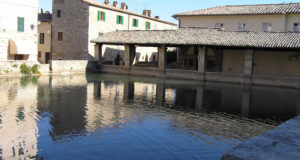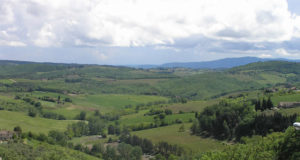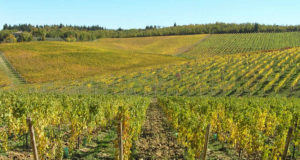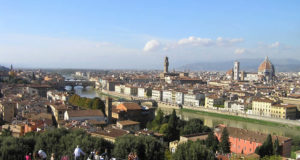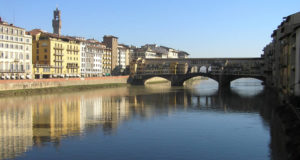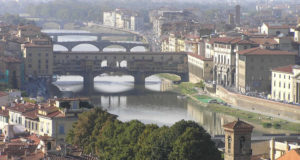At the end of the wall of the Salone dei Cinquecento (the one where the entrance is), there is a small masterpiece of Florentine mannerism, the study of Francesco I (in Italian “Studiolo di Francesco I” also called Tesoretto or Scrittoio del Duca). It is a small side room without windows that was part of the private apartments of Francesco ...
Read More »The Courtyard of Palazzo Vecchio, Florence
The first courtyard of Palazzo Vecchio was built in the first half of the fourteenth century and then modified by Michelozzo in the fifteenth century. This architect replaced the pillars with cylindrical and octagonal columns and then built the loggia. In the second half of the 16th century, the entire building underwent major modification works carried out by Vasari at ...
Read More »Palazzo Vecchio: one of the symbols of Florence
One of the symbols of Florence, Palazzo Vecchio or Palazzo della Signoria was designed by Arnolfo di Cambio around 1299 as the residence of the Priors of the Arts, the palace was completed in 1314. The 94-meter-high tower of Palazzo Vecchio, called the tower of Arnolfo was built in 1310, together with the palace. It was probably supported by an ...
Read More »The Importuno by Michelangelo, Palazzo Vecchio
Florence is a historic city full of legends. Among these there is a singular one concerning Michelangelo Buonnarroti. The great artist author of the David and the Pietà could have made one of his works in a stone of Palazzo Vecchio. But what is most surprising in the legend is the way in which the artist would have created the ...
Read More »Quarters of Pope Leo X in Palazzo Vecchio
Hall of Leo X and the Hall of Clement VII The Quarters of Pope Leo X are on the first floor of the Palazzo Vecchio, these rooms were modernized by Giorgio Vasari in 1555-62. The decorations of the same Vasari and Gino Lorenzi, are dedicated to the most illustrious personages of the Medici family and their businesses. These rooms have been used in ...
Read More »Hall of Geographical Maps in Palazzo Vecchio
At the end of the museum itinerary is the Hall of Geographical Maps (Sala delle Carte Geografiche) or Stanza del Guardaroba. In this room was originally the Medici Wardrobe of Grand Duke Cosimo I. That is, the seat of the institution that preserved, inventoried and moved all the assets of the State and the Sovereign. The room has a beautiful ...
Read More »Basilica of San Miniato al Monte
A masterpiece of Tuscan Romanesque in Florence The Basilica of San Miniato al Monte rises on a hill to south-east of the historical center of Florence, near Piazzale Michelangelo, and is considered one of the finest examples of Florentine Romanesque style. Built between the eleventh and the thirteenth century, contains works of great value as the chapel of the Cardinal ...
Read More »Grotta del Buontalenti: a grotto in the Boboli Gardens
The Buontalenti Grotto was built, designed and conceived between 1583 and 1593 by Bernardo Buontalenti (Florence 1536-1608). This Grotto is one of the most important places in the Boboli Gardens, it is an artificial cave filled with false stalactites and stalagmites, with statues of sheep, shepherds and Roman gods. Buontalenti Grotto represents one of the most valuable examples of Mannerist ...
Read More »Salone dei Cinquecento in Palazzo Vecchio, Florence
The Salone dei Cinquecento was built in 1495, during the period of restoration of the Florentine Republic. That is, after the expulsion of Piero de’ Medici in 1494. The work was done by Simone del Pollaiuolo called “il Cronaca” (1457-1508) assisted by Francesco di Domenico and Antonio da Sangallo. The huge hall was built at the behest of Frà Girolamo ...
Read More »Uffizi Gallery: the most important museum of Florence
Uffizi Gallery is the most important museum of Florence and one of the most famous museums in the world. The building houses a superb collection of works of art, divided into several rooms arranged for schools and styles in chronological order. This is an immense artistic heritage, which includes thousands of pictures ranging from the medieval to modern, a large ...
Read More »The farmhouses in Tuscany: in contact with nature
The Agriturismo is a typically Italian hospitality system. Over the years, this tourist reception system has taken on an increasingly tourist and less and less agricultural dimension. By developing facilities that provide the customer with numerous comforts and services such as swimming pools, massages, saunas, riding stables, etc. Tuscany is the Italian region that has the largest number of farmhouses. ...
Read More »The Spas of Tuscany: the region richest in spas
Tuscany, among the Italian regions, is without doubt the most rich in spas, just to mention some popular locations in the world as Montecatini Terme, Chianciano Terme, Saturnia. This region is in fact rich in deposits of thermal water that make it together with Emilia Romagna and Veneto, the most important Italian region for spas. Tuscany is a region that ...
Read More »Itinerary in the Florentine Chianti
Our itinerary in Florentine Chianti starts from the city of Florence. The starting point is the Firenze-Impruneta (ex Firenze-Certosa) exit of the Autostrada del Sole. The first stop is the town of San Casciano in Val di Pesa. Along the route we can make a detour of a few kilometers to visit the famous Albergaccio del Machiavelli. This is located ...
Read More »Chianti: the hilly heart of Tuscany
Chianti, ie the territory which for centuries produced the wine Chianti Classico, is part of the Tuscan hill land situated between Florence and Siena, expertly shaped by man and rich of art, this area is a mosaic of history, nature and art unique in the world. This is a land of ancient traditions, civilized in ancient times, first by the ...
Read More »Piazzale Michelangelo: the viewpoint of Florence
Piazzale Michelangelo is together with the Forte di Belvedere, the Basilica of San Miniato al Monte and the hill of Fiesole, one of the privileged viewpoints over Florence. The Piazzale designed in 1860 by the architect Giuseppe Poggi, is located on a hill south of the Arno and the historic center of Florence. This belvedere was built in 1865, at ...
Read More »Ponte Vecchio: the most famous bridge in Florence
The Ponte Vecchio is the oldest bridge in Florence, its origin dates back to Roman times. But it was repeatedly damaged by the floods of the Arno. Following this it was rebuilt several times. The structure crosses the river at its narrowest point and is today one of the symbols of the city of Florence. In medieval times it was ...
Read More »The climate of Florence: when to go to Florence
The city of Florence has a temperate Mediterranean climate, with hot, dry summers and cold, damp winters. The climate of Florence is influenced by its location in a valley at the foot of the Apennines to the north and surrounded by the hills of Chianti to the south. Summers are very hot with average maximum temperatures of over 30 ° ...
Read More » Borghi di Toscana Guida ai borghi e ai paesaggi della Toscana
Borghi di Toscana Guida ai borghi e ai paesaggi della Toscana
